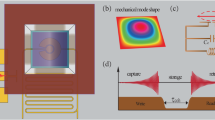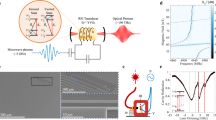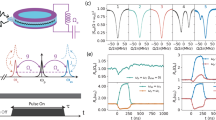Abstract
Superconducting qubits possess outstanding capabilities for processing quantum information in the microwave domain; however they have limited coherence times. An interface between photons and phonons could allow quantum information to be stored in long-lived mechanical oscillators. Here, we introduce a platform that relies on electrostatic forces in nanoscale structures to achieve strong coupling between a superconducting qubit and a nanomechanical oscillator with an energy decay time (T1) of approximately 25 ms, well beyond those achieved in integrated superconducting circuits. We use quantum operations in this system to investigate the microscopic origins of mechanical decoherence and mitigate its impact. By using two-pulse dynamical decoupling sequences, we can extend the coherence time (T2) from 64 μs to 1 ms. These findings establish that mechanical oscillators can act as quantum memories for superconducting devices, with potential future applications in quantum computing, sensing and transduction.
This is a preview of subscription content, access via your institution
Access options
Access Nature and 54 other Nature Portfolio journals
Get Nature+, our best-value online-access subscription
$32.99 / 30 days
cancel any time
Subscribe to this journal
Receive 12 print issues and online access
$259.00 per year
only $21.58 per issue
Buy this article
- Purchase on SpringerLink
- Instant access to full article PDF
Prices may be subject to local taxes which are calculated during checkout





Similar content being viewed by others
Data availability
The source data used to generate the plots in the paper are available via Zenodo at https://doi.org/10.5281/zenodo.15069397 (ref. 68). Other datasets produced or examined in this study can be obtained from the corresponding author (M.M.) upon reasonable request.
References
Wallquist, M., Hammerer, K., Rabl, P., Lukin, M. & Zoller, P. Hybrid quantum devices and quantum engineering. Phys. Scr. 2009, 014001 (2009).
Kurizki, G. et al. Quantum technologies with hybrid systems. Proc. Natl Acad. Sci. USA 112, 3866–3873 (2015).
Clerk, A. A., Lehnert, K. W., Bertet, P., Petta, J. R. & Nakamura, Y. Hybrid quantum systems with circuit quantum electrodynamics. Nat. Phys. 16, 257–267 (2020).
Kjaergaard, M. et al. Superconducting qubits: current state of play. Annu. Rev. Condens. Matter Phys. 11, 369–395 (2020).
de Leon, N. P. et al. Materials challenges and opportunities for quantum computing hardware. Science 372, eabb2823 (2021).
Galliou, S. et al. Extremely low loss phonon-trapping cryogenic acoustic cavities for future physical experiments. Sci. Rep. 3, 2132 (2013).
Engelsen, N. J., Beccari, A. & Kippenberg, T. J. Ultrahigh-quality-factor micro- and nanomechanical resonators using dissipation dilution. Nat. Nanotechnol. 19, 725–737 (2024).
MacCabe, G. S. et al. Nano-acoustic resonator with ultralong phonon lifetime. Science 370, 840–843 (2020).
Samanta, C. et al. Nonlinear nanomechanical resonators approaching the quantum ground state. Nat. Phys. 19, 1340–1344 (2023).
Chamberland, C. et al. Building a fault-tolerant quantum computer using concatenated cat codes. PRX Quantum 3, 010329 (2022).
Hann, C. T. et al. Hardware-efficient quantum random access memory with hybrid quantum acoustic systems. Phys. Rev. Lett. 123, 250501 (2019).
Pechal, M., Arrangoiz-Arriola, P. & Safavi-Naeini, A. H. Superconducting circuit quantum computing with nanomechanical resonators as storage. Quantum Sci. Technol. 4, 015006 (2018).
Chu, Y. & Gröblacher, S. A perspective on hybrid quantum opto- and electromechanical systems. Appl. Phys. Lett. 117, 150503 (2020).
Pirkkalainen, J.-M. et al. Hybrid circuit cavity quantum electrodynamics with a micromechanical resonator. Nature 494, 211–215 (2013).
Ma, X., Viennot, J. J., Kotler, S., Teufel, J. D. & Lehnert, K. W. Non-classical energy squeezing of a macroscopic mechanical oscillator. Nat. Phys. 17, 322–326 (2021).
LaHaye, M. D., Suh, J., Echternach, P. M., Schwab, K. C. & Roukes, M. L. Nanomechanical measurements of a superconducting qubit. Nature 459, 960–964 (2009).
Rouxinol, F. et al. Measurements of nanoresonator-qubit interactions in a hybrid quantum electromechanical system. Nanotechnology 27, 364003 (2016).
O’Connell, A. D. et al. Quantum ground state and single-phonon control of a mechanical resonator. Nature 464, 697–703 (2010).
Chu, Y. et al. Quantum acoustics with superconducting qubits. Science 358, 199–202 (2017).
Wollack, E. A. et al. Quantum state preparation and tomography of entangled mechanical resonators. Nature 604, 463–467 (2022).
Bild, M. et al. Schrödinger cat states of a 16-microgram mechanical oscillator. Science 380, 274–278 (2023).
Qiao, H. et al. Splitting phonons: building a platform for linear mechanical quantum computing. Science 380, 1030–1033 (2023).
Ganjam, S. et al. Surpassing millisecond coherence in on chip superconducting quantum memories by optimizing materials and circuit design. Nat. Commun. 15, 3687 (2024).
Crowley, K. D. et al. Disentangling losses in tantalum superconducting circuits. Phys. Rev. X 13, 041005 (2023).
Tuokkola, M. et al. Methods to achieve near-millisecond energy relaxation and dephasing times for a superconducting transmon qubit. Preprint at https://arxiv.org/abs/2407.18778 (2024).
McGuigan, D. F. et al. Measurements of the mechanical Q of single-crystal silicon at low temperatures. J. Low Temp. Phys. 30, 621–629 (1978).
Beccari, A. et al. Strained crystalline nanomechanical resonators with quality factors above 10 billion. Nat. Phys. 18, 436–441 (2022).
Tao, Y., Boss, J. M., Moores, B. A. & Degen, C. L. Single-crystal diamond nanomechanical resonators with quality factors exceeding one million. Nat. Commun. 5, 3638 (2014).
Liu, Y. et al. Degeneracy-breaking and long-lived microwave electromechanical systems enabled by cubic silicon-carbide membrane crystals. Nat. Commun. 16, 1207 (2025).
Behunin, R. O., Intravaia, F. & Rakich, P. T. Dimensional transformation of defect-induced noise, dissipation, and nonlinearity. Phys. Rev. B 93, 224110 (2016).
Mason, D., Chen, J., Rossi, M., Tsaturyan, Y. & Schliesser, A. Continuous force and displacement measurement below the standard quantum limit. Nat. Phys. 15, 745–749 (2019).
McCormick, K. C. et al. Quantum-enhanced sensing of a single-ion mechanical oscillator. Nature 572, 86–90 (2019).
Barzanjeh, S. et al. Optomechanics for quantum technologies. Nat. Phys. 18, 15–24 (2022).
Bozkurt, A. et al. A quantum electromechanical interface for long-lived phonons. Nat. Phys. 19, 1326–1332 (2023).
Wollack, E. A. et al. Loss channels affecting lithium niobate phononic crystal resonators at cryogenic temperature. Appl. Phys. Lett. 118, 123501 (2021).
Mason, W. P. & McSkimin, H. J. Attenuation and scattering of high frequency sound waves in metals and glasses. J. Acoust. Soc. Am. 19, 464–473 (1947).
Catto, G. et al. Microwave response of a metallic superconductor subject to a high-voltage gate electrode. Sci. Rep. 12, 6822 (2022).
Geerlings, K. et al. Demonstrating a driven reset protocol for a superconducting qubit. Phys. Rev. Lett. 110, 120501 (2013).
Satzinger, K. J. et al. Quantum control of surface acoustic-wave phonons. Nature 563, 661–665 (2018).
Chu, Y. et al. Creation and control of multi-phonon Fock states in a bulk acoustic-wave resonator. Nature 563, 666–670 (2018).
Yang, Y. et al. A mechanical qubit. Science 386, 783–788 (2024).
Bienfait, A. et al. Phonon-mediated quantum state transfer and remote qubit entanglement. Science 364, 368–371 (2019).
Cleland, A. Y., Wollack, E. A. & Safavi-Naeini, A. H. Studying phonon coherence with a quantum sensor. Nat. Commun. 15, 4979 (2024).
Emser, A. L., Metzger, C., Rose, B. C. & Lehnert, K. W. Thin-film quartz for high-coherence piezoelectric phononic crystal resonators. Phys. Rev. Appl. 22, 064032 (2024).
Kleiman, R. N., Agnolet, G. & Bishop, D. J. Two-level systems observed in the mechanical properties of single-crystal silicon at low temperatures. Phys. Rev. Lett. 59, 2079–2082 (1987).
von Lüpke, U. et al. Parity measurement in the strong dispersive regime of circuit quantum acoustodynamics. Nat. Phys. 18, 794–799 (2022).
Wallucks, A., Marinković, I., Hensen, B., Stockill, R. & Gröblacher, S. A quantum memory at telecom wavelengths. Nat. Phys. 16, 772–777 (2020).
Lisenfeld, J. et al. Electric field spectroscopy of material defects in transmon qubits. npj Quantum Inf 5, 105 (2019).
Sarabi, B., Ramanayaka, A. N., Burin, A. L., Wellstood, F. C. & Osborn, K. D. Projected dipole moments of individual two-level defects extracted using circuit quantum electrodynamics. Phys. Rev. Lett. 116, 167002 (2016).
Phillips, W. A. Two-level states in glasses. Rep. Prog. Phys. 50, 1657–1708 (1987).
Carr, H. Y. & Purcell, E. M. Effects of diffusion on free precession in nuclear magnetic resonance experiments. Phys. Rev. 94, 630 (1954).
Arenz, C., Burgarth, D. & Hillier, R. Dynamical decoupling and homogenization of continuous variable systems. J. Phys. A 50, 135303 (2017).
Ithier, G. et al. Decoherence in a superconducting quantum bit circuit. Phys. Rev. B 72, 134519 (2005).
Bylander, J. et al. Noise spectroscopy through dynamical decoupling with a superconducting flux qubit. Nat. Phys. 7, 565–570 (2011).
Chakram, S. et al. Multimode photon blockade. Nat. Phys. 18, 879–884 (2022).
Jones, W. M., Lukin, D. & Scherer, A. Practical nanoscale field emission devices for integrated circuits. Appl. Phys. Lett. 110, 263101 (2017).
Najera-Santos, B.-L. et al. High-sensitivity ac-charge detection with a MHz-frequency fluxonium qubit. Phys. Rev. X 14, 011007 (2024).
Lee, N. R. et al. Strong dispersive coupling between a mechanical resonator and a fluxonium superconducting qubit. PRX Quantum 4, 040342 (2023).
Rosenberg, D. et al. 3D integrated superconducting qubits. npj Quantum Inf 3, 42 (2017).
Conner, C. R. et al. Superconducting qubits in a flip-chip architecture. Appl. Phys. Lett. 118, 232602 (2021).
Guillaud, J. & Mirrahimi, M. Repetition cat qubits for fault-tolerant quantum computation. Phys. Rev. X 9, 041053 (2019).
Tuckett, D. K., Bartlett, S. D. & Flammia, S. T. Ultrahigh error threshold for surface codes with biased noise. Phys. Rev. Lett. 120, 050505 (2018).
Jeffrey, E. et al. Fast accurate state measurement with superconducting qubits. Phys. Rev. Lett. 112, 190504 (2014).
Sank, D. et al. System characterization of dispersive readout in superconducting qubits. Phys. Rev. Appl. 23, 024055 (2025).
Zhang, Y. et al. Engineering bilinear mode coupling in circuit QED: theory and experiment. Phys. Rev. A 99, 012314 (2019).
Keller, A. J. et al. Al transmon qubits on silicon-on-insulator for quantum device integration. Appl. Phys. Lett. 111, 042603 (2017).
Card, H. Aluminum–silicon Schottky barriers and ohmic contacts in integrated circuits. IEEE Trans. Electron Devices 23, 538–544 (1976).
Bozkurt, A. B., Golami, O., Yu, Y., Tian, H. & Mirhosseini, M. Data for the article entitled: ‘A mechanical quantum memory for microwave photons’. Zenodo https://doi.org/10.5281/zenodo.15069397 (2025).
Acknowledgements
We acknowledge O. Painter, M. Kalaee, H. Zhao, C. Joshi, F. Yang, P. Shah and W. Chen for helpful discussions. This work was supported by the AFOSR (Award No. FA9550-23-1-0062) and the NSF (Award Nos. 2137776 and 2238058). A.B.B. gratefully acknowledges support from the Eddleman Graduate Fellowship. H.T. gratefully acknowledges support from an IQIM Postdoctoral Fellowship.
Author information
Authors and Affiliations
Contributions
M.M., A.B.B. and O.G. conceived and designed the experiment. Y.Y. performed the numerical optimization of the devices. A.B.B., O.G. and H.T. fabricated the devices. A.B.B., O.G. and M.M. conducted the measurements and analysed the data. A.B.B., O.G. and M.M. wrote the paper with input from all authors. M.M. supervised the project.
Corresponding author
Ethics declarations
Competing interests
M.M., A.B.B. and O.G. acknowledge a provisional patent application that draws on the work described in this manuscript. The other authors declare no competing interests.
Peer review
Peer review information
Nature Physics thanks Gary Steele, Marius Villiers and the other, anonymous, reviewer(s) for their contribution to the peer review of this work.
Additional information
Publisher’s note Springer Nature remains neutral with regard to jurisdictional claims in published maps and institutional affiliations.
Extended data
Supplementary information
Supplementary Information
Supplementary Sections A–K, Figs. 1–16 and Table 1.
Rights and permissions
Springer Nature or its licensor (e.g. a society or other partner) holds exclusive rights to this article under a publishing agreement with the author(s) or other rightsholder(s); author self-archiving of the accepted manuscript version of this article is solely governed by the terms of such publishing agreement and applicable law.
About this article
Cite this article
Bozkurt, A.B., Golami, O., Yu, Y. et al. A mechanical quantum memory for microwave photons. Nat. Phys. 21, 1469–1474 (2025). https://doi.org/10.1038/s41567-025-02975-w
Received:
Accepted:
Published:
Issue date:
DOI: https://doi.org/10.1038/s41567-025-02975-w
This article is cited by
-
Acoustic phonon phase gates with number-resolving phonon detection
Nature Physics (2025)



